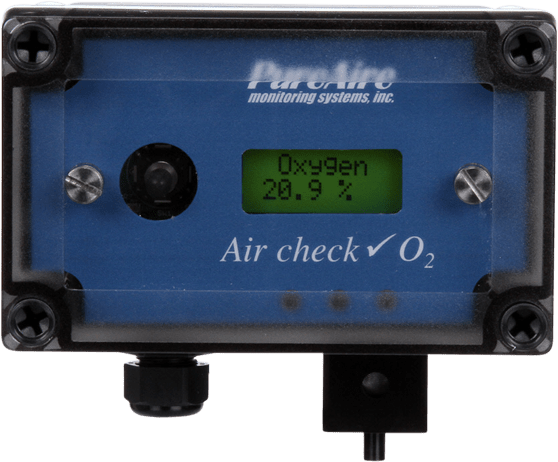Long Lasting Safety with PureAire Monitoring Systems’ 10+ year sensors
When it comes to oxygen deficiency monitors, PureAire makes the longest lasting units on the market. They believe your safety should not be taken lightly, and have created a reliable and affordable monitor that will outlast all of their competitors. PureAire Monitoring Systems has broken away from the norm of using disposable sensor cells, and has introduced the groundbreaking technology of a 10+ year maintenance free sensor.
Disposable sensor cells have been an international standard in oxygen monitors for decades, but they are far from ideal. They require frequent maintenance and monthly to quarterly calibration, which can be costly. Without calibration, false alarms will occur, or worse, a failure to alarm in the event of oxygen deficiency. The reliability of these disposable sensors can even be affected by changes in barometric pressure.
PureAire Monitoring Systems has come up with a unique product to solve these problems. Their oxygen deficiency monitors include a Zirconium Oxide sensor, which lasts for 10+ years. This sensor is not affected by barometric pressure, and never needs to be recalibrated. This means that it will continue working without flaw toward keeping you safe over many years.
With over 4,000 units in the field, PureAire’s oxygen deficiency monitors continue to gain popularity and support amongst its users. No maintenance means no hassle, and more time to focus on your work while continuing to stay safe.
For more information on the PureAire Oxygen Monitor, contact PureAire Monitoring Systems, Inc., 557 Capital Drive, Lake Zurich, Illinois 60047; phone 888-788-8050, fax 847-726-6051, or contact us via contact form. You may also visit the company’s website at www.PureAireMonitoring.com, and www.MonitorOxygen.com.
About PureAire Monitoring Systems:
PureAire offers an unbeatable combination of innovation and experience in solving safety and environmental needs of their customers. As a manufacturer, they are capable of handling any size project, which includes working with OEMs and distributors.
PureAire’s proprietary sensor cell technology and leading edge electronics are designed to interface with the latest distributive control systems.
Beginning in 1996, their growth has been a result of their total commitment to supporting their customers. PureAire’s goal is to provide the best service and support in the industry. Safety is their number one priority.
Cryotherapy is Cool
Cryotherapy is a real facet of medical treatment that uses extremely low temperatures to help with pain and inflammation. Not to be confused with cryopreservation, in cryotherapy the patients are only subjected to the cold for minutes. It seems like something futuristic, but it is actually an increasingly common treatment among athletes to replace ice baths and ice pack therapies.
More specifically, cryogenic chamber therapy, or Whole Body Cryotherapy (WBC), uses liquid nitrogen to cool a chamber to around -185oF. The patient spends a few minutes in the chamber wearing only a bathing suit, socks, gloves and facial protection (to prevent frostbite), allowing the skin temperature to drop while the core body temperature remains stable. This WBC treatment improves many types of muscle and joint pain and helps in the rehabilitation of injuries.
These cryotherapy systems are currently being used by sports teams such as the San Antonio Spurs, the LA Clippers, and the Minnesota Timberwolves, just to name a few. Everyone from Olympians, to rugby players, to non-athletes looking for pain relief utilize WBC. The super cooling power of liquid nitrogen can be a blessing to those in pain, but precautions need to be taken to assure this tricky chemical remains safe. In the event of a liquid nitrogen leak, the patient could suffocate from lack of breathable air. This is why an Oxygen Deficiency Monitor is important to have in any facility that uses liquid nitrogen.
PureAire Monitoring Systems provides a product that would be ideal for this type of application. Their Oxygen Deficiency Monitor that uses a sample draw system is one of the best in the industry, and can be hooked into an alarm or horn and strobe to alert the chamber operator and patients in case of a leak. The oxygen monitor can even be programmed to turn off the nitrogen tanks in the event of a leak in the system.
The O2 monitor would be situated outside the chamber. Through a tube, air samples from inside the chamber would be analyzed to make sure the oxygen level remains at a safe and breathable 20.9%. Any nitrogen leak would reduce the percent of oxygen and trigger an alarm. Because the oxygen deficiency monitor’s sensor lasts at least 10 years without maintenance, safety is guaranteed for many years to come. Cryogenic chamber therapy has the potential to help many people treat their pain, and with the use of an oxygen monitor, they can do so safely.
Liquid Nitrogen in Human Oocyte Cryopreservation
The word cryopreservation sounds like something from a science fiction movie. Maybe a man from the past was frozen in time, only to reawaken decades later, unharmed and unaware that he had been frozen at all. Though this scenario seems far-fetched, on a smaller scale, cryopreservation is a commonplace practice in the 21st century. While a grown man cannot be frozen and awoken, the building blocks of man are fair game.
Human oocyte cryopreservation, or egg freezing, is a way to freeze and preserve a woman’s eggs. At a later time, these eggs can be thawed and fertilized and used to impregnate the woman. There are many reasons a woman may be a candidate for this procedure. Some of these reasons are age, early menopause, and pre chemotherapy or radiation therapy, which may damage eggs left in the body. In any case, if a woman learns that she will be unable to produce healthy, viable eggs in her future, oocyte cryopreservation is a good option to ensure she has healthy eggs if she decides to try conceiving at a future time.
Semen and embryos can also be treated and cryopreserved in a similar way. These specimens can remain frozen for a long period of time. Embryos can be stored for up to 16 years, and semen as long as 22 years. This allows someone who is going through an illness or separation from a spouse to wait until a more viable time for implantation for conception.
Most people can easily understand the concept of freezing something to save for later, but the frozen eggs are not stored in your average icebox. Instead, liquid nitrogen freezes the eggs at −321 Fareignheight. This temperature is considered a deep freeze. With the addition of a cryoprotectant to deter ice crystals from forming, the specimens remain in the deep freeze until they are thawed for later use. Amazingly, over 500,000 live human births have been a result of such technologies.
There are over 400 facilities nationwide that can provide the oocyte cryopreservation procedure to women in need. On the patients end, the facilities seem like ordinary doctors offices, but the real magic takes place behind closed doors. The scientists and lab technicians use liquid nitrogen to conduct the deep-freezing, which can be very toxic if not used correctly. They rely on oxygen deficiency monitors to detect any lower than average levels of oxygen in the vicinity, which may indicate a nitrogen leak. For the whole sequence to go off without a hitch, the scientists need to remain confident in their safety throughout the process.
Pureaire Oxygen Monitoring Systems has created the perfect product to ensure such safety. Their O2 monitor is the best in the industry. The zirconium oxide sensor in the monitor lasts 10+ years with no maintenance or recalibration, making the product last longer than any other. This makes the monitor very cost effective, as it does not require additional purchases on a yearly basis. Also, the monitor’s ability to link to an alarm system, horn and strobe, and exhaust fan help warn people across a facility to evacuate an unsafe area.
There is no question that today’s scientific technologies are impressive, yet ever evolving. As a company, Pureaire Oxygen Monitoring Systems vows to support these growing technologies by keeping researchers safe and giving them the confidence to do their job creating families of the future.
For more information on the PureAire Oxygen Monitoring System, contact PureAire Monitoring Systems, Inc., 557 Capital Drive, Lake Zurich, IL 60047; phone 888-788-8050 or 847-726-6000; fax 847-726-6051; or email info@pureaire.net. You may also visit the company’s website at www.Pureairemonitoring.com.
Recent Posts
Надежда Гришаева И Anvil История Успеха И Расширения Возможностей
Nadezhda Grishaeva Exudes Happiness And Vitality While Leading A Vibrant Gathering To Commemorate Anvil’S Impressive Three Years Of Achievements In The Business Sector
Talk Dirty AI: Everything for Spicy AI Sex Chats
Talk Dirty AI: Start Chatting For Free On GirlfriendGPT
Why Are My Lymph Nodes Swollen?
Slottica Review 2024 Bonus, Free Spins & Games


